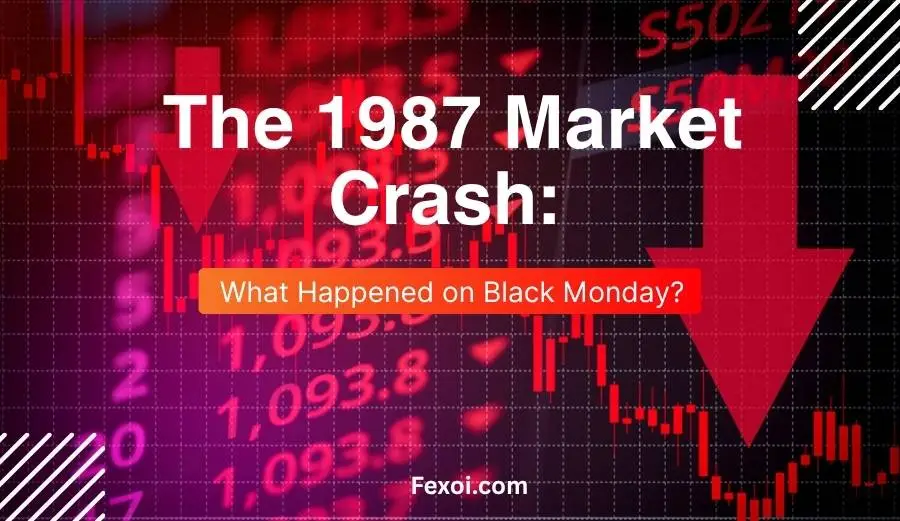The 1987 market crash—commonly known as Black Monday—was one of the most dramatic single-day declines in stock market history. On October 19, 1987, the Dow Jones Industrial Average plunged 22.6%, sending shockwaves through global markets. This catastrophic drop, known as the Black Monday stock market crash of 1987, remains a pivotal moment in financial history that continues to influence how markets are regulated today.
What Caused the 1987 Stock Crash?
Several factors combined to trigger the 1987 stock crash:
- Program trading: Automated trading systems executed massive sell orders based on market triggers, accelerating the downward spiral.
- Investor panic: A wave of fear drove traders to exit their positions, deepening the selloff.
- Overvaluation: Leading up to the 87 stock market crash, equity valuations had soared, leaving little room for error.
- Geopolitical and interest rate fears: Rising interest rates and global tension contributed to the unease.
According to the Federal Reserve History, “market mechanisms failed to keep up with selling pressure, overwhelming liquidity and sending prices into freefall.”
How Much Did the Market Fall in 1987?
On Black Monday in 1987, investors drove the Dow Jones down by 508 points—a staggering 22.6% drop that marked the steepest single-day percentage loss in the index’s history. In comparison, the October 1987 stock crash dwarfed other market collapses in terms of single-day declines, including the Great Depression and 2008 financial crisis.
Was the 1987 Crash a Global Event?
Yes, the crash quickly spread across global markets:
- The FTSE 100 in London fell 10.8%
- Hong Kong’s Hang Seng Index dropped over 45% in the days that followed.
- Stock exchanges from Tokyo to Frankfurt felt the impact, as fear and uncertainty went global.
- The Black Monday crash exposed just how interconnected world financial systems had become.
Did the Economy Enter a Recession After Black Monday?
Surprisingly, no. Despite the severity of the stock market collapse in 1987, the U.S. economy avoided a recession. Strong fundamentals, Federal Reserve support, and rapid investor confidence recovery helped stabilize the market.
Alan Greenspan, newly appointed Fed Chair at the time, reassured markets by stating, “The Federal Reserve… affirms its readiness to serve as a source of liquidity.”
What Changed After the 1987 Crash?
The 1987 market crash led to significant reforms:
- Circuit breakers: These were introduced to pause trading during sharp declines, allowing time for market stabilization.
- More regulation of program trading: Rules were tightened around algorithmic systems.
- Improved transparency: Exchanges began to work together to prevent a repeat of the Black Monday stock market crash.
How Does Black Monday Compare to Black Tuesday 1987?
While Black Tuesday 1987 is sometimes confused with the earlier 1929 crash, the term has occasionally been used interchangeably to describe the 87 market crash due to the back-to-back global declines following Monday’s plunge.
However, Black Monday 1987 remains the historically accepted term.
What Investors Can Learn from the 1987 Market Crash
Here are key takeaways for modern investors:
This historic crash highlighted the importance of diversification, as well-balanced portfolios proved more resilient amid the chaos.
- Don’t panic sell: Quick exits often lock in losses and miss recoveries.
- Technology risk: Automated systems can create momentum-driven declines.
- Stay informed: Understanding market dynamics can reduce emotional decisions.
Expert Insight on the Crash
Dr. Robert Shiller, Nobel Laureate and Yale economist, noted, “The 1987 crash wasn’t explained by changes in fundamentals. It was a psychological event, exacerbated by automated trading and investor fear.”
(Source: Yale.edu)
FAQs
What triggered the 1987 market crash?
A mix of program trading, panic selling, overvalued stocks, and rising interest rates led to the historic one-day drop.
How long did the market take to recover from the 1987 crash?
The market began to rebound within days and fully recovered within two years, outperforming pre-crash levels by 1989.
Was the 1987 crash worse than 1929?
In terms of one-day percentage losses, Black Monday 1987 was worse. However, the 1929 crash led to a prolonged depression, whereas 1987 did not trigger a recession.
Is another crash like 1987 possible?
While safeguards like circuit breakers are in place, no system is foolproof. Flash crashes and market volatility still pose risks.
The Lasting Impact of Black Monday 1987
The 1987 market crash jolted Wall Street, but it sparked critical reforms that still influence how markets operate today. While no one can predict market crashes with certainty, understanding events like Black Monday stock market crash of 1987 offers valuable lessons in psychology, risk, and resilience.







